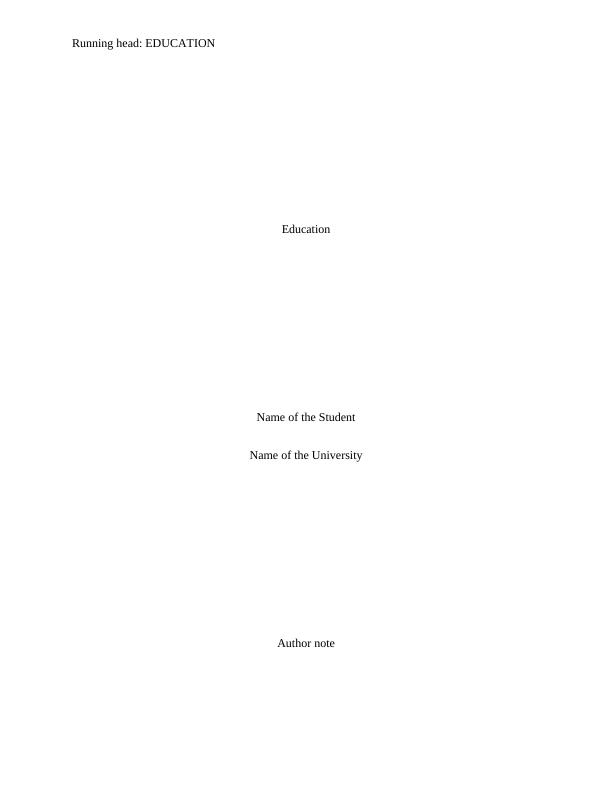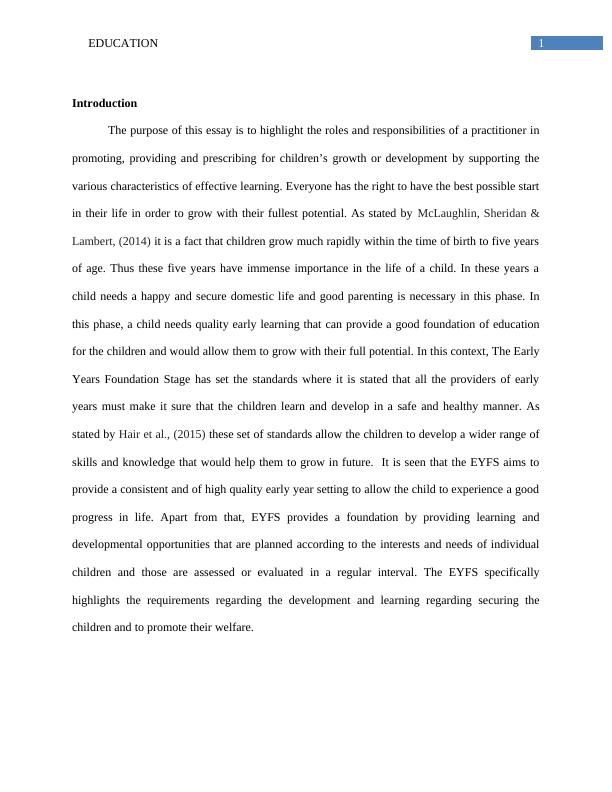Education Assignment | Role & Responsibility of Practitioner
Added on 2020-05-28
19 Pages5559 Words152 Views
Running head: EDUCATIONEducationName of the StudentName of the UniversityAuthor note

1EDUCATIONIntroductionThe purpose of this essay is to highlight the roles and responsibilities of a practitioner inpromoting, providing and prescribing for children’s growth or development by supporting thevarious characteristics of effective learning. Everyone has the right to have the best possible startin their life in order to grow with their fullest potential. As stated by McLaughlin, Sheridan &Lambert, (2014) it is a fact that children grow much rapidly within the time of birth to five yearsof age. Thus these five years have immense importance in the life of a child. In these years achild needs a happy and secure domestic life and good parenting is necessary in this phase. Inthis phase, a child needs quality early learning that can provide a good foundation of educationfor the children and would allow them to grow with their full potential. In this context, The EarlyYears Foundation Stage has set the standards where it is stated that all the providers of earlyyears must make it sure that the children learn and develop in a safe and healthy manner. Asstated by Hair et al., (2015) these set of standards allow the children to develop a wider range ofskills and knowledge that would help them to grow in future. It is seen that the EYFS aims toprovide a consistent and of high quality early year setting to allow the child to experience a goodprogress in life. Apart from that, EYFS provides a foundation by providing learning anddevelopmental opportunities that are planned according to the interests and needs of individualchildren and those are assessed or evaluated in a regular interval. The EYFS specificallyhighlights the requirements regarding the development and learning regarding securing thechildren and to promote their welfare.

2EDUCATIONPromotingIt is important to create a safe, secure yet challenging environment for promotingchildren’s learning through play. As disclosed by McLaughlin, Sheridan & Lambert, (2014), Asearly childhood education is a major thing for the growth and development of the children,learning through play has a major influence behind the development of a child. While planningto provide play environments for children for learning purposes, the useful components willinclude lighting, various resources, acoustics and relevant furniture. For an example, a readinglamp that is attached to a table for learning might help the child to be able to focus more. In thisway, various provocations for learning would bring in sensory exploration and investigation byusing a variety of resources, technologies and media. For an example, it can be said that alovable collection of non-fiction books on the shelves can provoke the children’s interest to learnmore. As highlighted by McLaughlin, Sheridan & Lambert, (2014) beauty or the aesthetics of theroom for the children can attract children to learn more. In this scenario, the positioning of theresources and the equipments are also important. As stated by Hair et al., (2015) as if thepositioning of the items isgood, then it would allow the pupils to access them in a safe and securemanner and the children will be able to access them more swiftly and that would allow them tolearn quickly. The practitioner should provide necessary equipment and resources so that thepupils can use them safely with respect to their agency and competency. Apart from that thepractitioners should collaborate with the families of the children and others to evaluate thedevelopment of the children on a regular interval.An incessant support from the practitioners by positive interactions allows a good basisfor a learning environment that is emotionally supported for the children. As stated byMcLaughlin, Sheridan & Lambert, (2014), under this type of environment children’s physical,

3EDUCATIONsocial and emotional requirements gets satisfied. The adults make a warm caring environmentwhere the children learn and participate in parallel play with other children, and at the same timeacknowledge others achievements after recognizing their skills. In this way, the adults encourageother children to interact with others and also to help one another to solve their difficulties withthe tasks. In this way a practitioner can provide opportunities for the children to develop in aswift manner. In the early childhood, the social skills of the children are the primary indicators of thefuture success of that child. Like any other skills, social skills have an immense importance indetermining the future of the child. It is seen that the desired behaviors are learnt and taught by arange of experiences gathered in the early years of the childhood. Between the age of 0 to 5,children rapidly grow and develop than in any other stages of their lives. Thus to support andprovide the learning of the child the adults should enhance a positive teacher student relationshipand help the children to play and learn together.Children’s development means the expansion of the cognitive, psychological, socio-emotional and physical skills that canpotentially increase the autonomy, independence andcompetence of them. The experiences of children in their early childhood are extremelyimportantfor their further growth. The influence of the adults is very important for the growth anddevelopment of the children. As stated by Hair et al., (2015) the experiences of the adults areimmensely important for the further development of the children. Interventions to support andprotect early development of children ensure a great future of the children and the importance ofintervention is thus undoubted.

End of preview
Want to access all the pages? Upload your documents or become a member.
Related Documents
Early Childhood Education: PDFlg...
|12
|2859
|147
Assessment Planning and Observations in Early Education Frameworklg...
|6
|1186
|235
Promoting Inclusivity and Diversity in Early Year Educationlg...
|11
|3194
|162
Comparison of EYFS and Montessori Curriculalg...
|15
|3953
|2
The Early Years Foundation Stagelg...
|4
|342
|29
(PDF) Constructing an Understanding of Mindlg...
|11
|3102
|83
